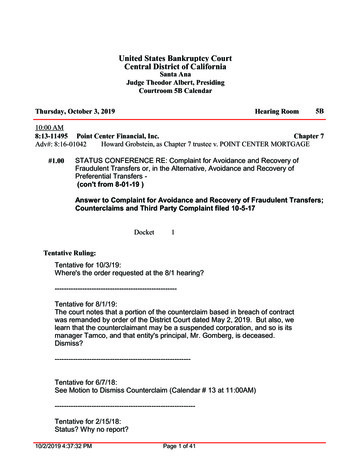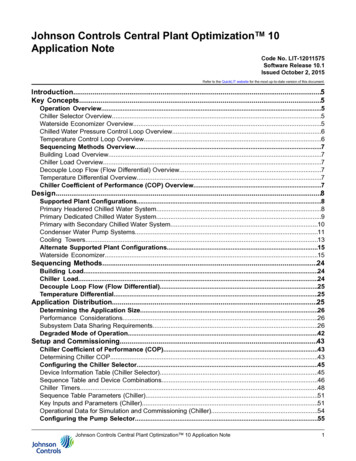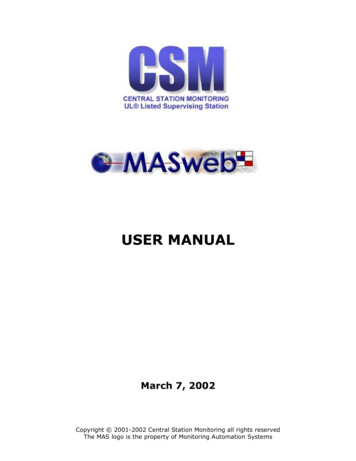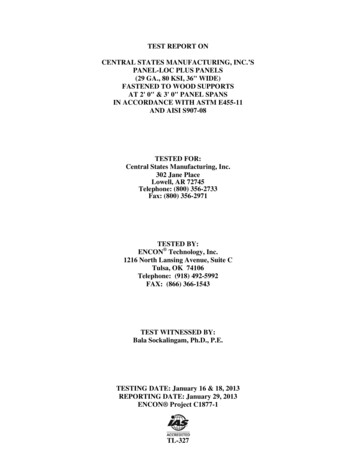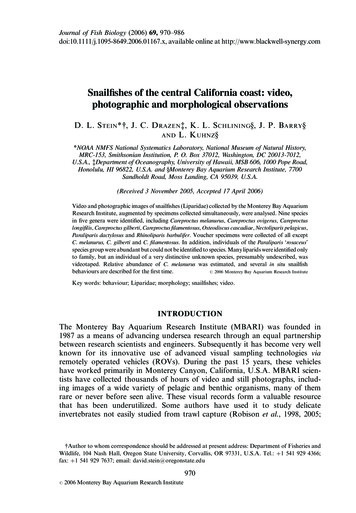
Transcription
Journal of Fish Biology (2006) 69, 970–986doi:10.1111/j.1095-8649.2006.01167.x, available online at http://www.blackwell-synergy.comSnailfishes of the central California coast: video,photographic and morphological observationsD. L. S TEIN *†, J. C. D RAZEN ‡, K. L. S CHLINING §, J. P. B ARRY §AND L. K UHNZ §*NOAA NMFS National Systematics Laboratory, National Museum of Natural History,MRC-153, Smithsonian Institution, P. O. Box 37012, Washington, DC 20013-7012,U.S.A., ‡Department of Oceanography, University of Hawaii, MSB 606, 1000 Pope Road,Honolulu, HI 96822, U.S.A. and §Monterey Bay Aquarium Research Institute, 7700Sandholdt Road, Moss Landing, CA 95039, U.S.A.(Received 3 November 2005, Accepted 17 April 2006)Video and photographic images of snailfishes (Liparidae) collected by the Monterey Bay AquariumResearch Institute, augmented by specimens collected simultaneously, were analysed. Nine speciesin five genera were identified, including Careproctus melanurus, Careproctus ovigerus, Careproctuslongifilis, Careproctus gilberti, Careproctus filamentosus, Osteodiscus cascadiae, Nectoliparis pelagicus,Paraliparis dactylosus and Rhinoliparis barbulifer. Voucher specimens were collected of all exceptC. melanurus, C. gilberti and C. filamentosus. In addition, individuals of the Paraliparis ‘rosaceus’species group were abundant but could not be identified to species. Many liparids were identified onlyto family, but an individual of a very distinctive unknown species, presumably undescribed, wasvideotaped. Relative abundance of C. melanurus was estimated, and several in situ snailfish# 2006 Monterey Bay Aquarium Research Institutebehaviours are described for the first time.Key words: behaviour; Liparidae; morphology; snailfishes; video.INTRODUCTIONThe Monterey Bay Aquarium Research Institute (MBARI) was founded in1987 as a means of advancing undersea research through an equal partnershipbetween research scientists and engineers. Subsequently it has become very wellknown for its innovative use of advanced visual sampling technologies viaremotely operated vehicles (ROVs). During the past 15 years, these vehicleshave worked primarily in Monterey Canyon, California, U.S.A. MBARI scientists have collected thousands of hours of video and still photographs, including images of a wide variety of pelagic and benthic organisms, many of themrare or never before seen alive. These visual records form a valuable resourcethat has been underutilized. Some authors have used it to study delicateinvertebrates not easily studied from trawl capture (Robison et al., 1998, 2005;†Author to whom correspondence should be addressed at present address: Department of Fisheries andWildlife, 104 Nash Hall, Oregon State University, Corvallis, OR 97331, U.S.A. Tel.: þ1 541 929 4366;fax: þ1 541 929 7637; email: david.stein@oregonstate.edu970#2006 Monterey Bay Aquarium Research Institute
VISUAL OBSERVATIONS OF CALIFORNIA SNAILFISHES971Silguero & Robison, 2000; Raskoff, 2002), but only a few incidentally recordedfishes from the dives have been studied (Drazen et al., 2003). Unlike some otherstudies using visual records from ROVs or submersibles (Pearcy et al., 1990;Stein et al., 1992, 2005; Felley & Vecchione, 1995), these data were collectedincidentally during other studies and are unquantifiable. They do not representnew methods of collecting data and do not illustrate data collection problems.The snailfishes (Liparidae) are one of the benthic fish families commonly seen inMonterey Canyon. The family has over 350 described species in c. 30 genera, manyof which are rare. Twenty-five of these species have been recorded from Californian waters (Chernova et al., 2004), but considering the species known from Oregon but not recorded from California (Chernova et al., 2004), the true numberoccurring in the region is probably much higher. With few exceptions, little isknown of their biology and behaviour; none have been studied in situ. As of August2001, MBARI videos included 421 occurrences of liparids from 158 ROV dives.Although many of these individuals could be identified only to family, individualsof nine species were identified: Careproctus melanurus Gilbert 1892, Careproctusovigerus (Gilbert 1896), Careproctus longifilis Garman 1892, Careproctus gilbertiBurke 1912, Careproctus filamentosus Stein 1978, Osteodiscus cascadiae Stein1978, Nectoliparis pelagicus Gilbert & Burke 1912, Paraliparis dactylosus Gilbert1896 and Rhinoliparis barbulifer Gilbert 1896. Voucher specimens were collectedof all except C. melanurus, C. gilberti and C. filamentosus. In addition, individualsof the Paraliparis ‘rosaceus’ Gilbert 1890 species group (Stein, 1978) were seen.These video and photographic data provide not only information on behaviour,appearance in situ and habitat, but also on frequency of occurrence, abundance,depth distribution and reproduction. Because all observations were obtained incidental to other studies, no experimentation or repetitive sampling was possible.MATERIALS AND METHODSMBARI’s video annotation reference system (VARS) database includes annotationsfor 16 000 video-tapes (c. 12 000 h) accumulated over 15 years, and is uniquely managed as a centralized institutional resource. The database contains 1 6 million individualrecords of the biological, chemical, geological and physical aspects primarily of theMonterey submarine canyon but also other areas including the Pacific Northwest,southern California basins, central California seamounts, northern California,Oregon, Hawaii and the Gulf of California. Each annotation is associated with navigationinformation and physical variables such as water temperature, salinity, depth and dissolved oxygen. The VARS was developed by MBARI engineers to facilitate the creation,storage and retrieval of video annotations, and includes 3000 biological, geologicaland technical search terms organized in a hierarchical system to allow for consistentand rapid classification, description and complex querying of objects observed on theROV video. System documentation can be found at http://www.mbari.org/vars/.Video footage used in this study was recorded by the MBARI ROVs Tiburon (T) andVentana (V), between 8 September 1989 and 26 August 2001. Tiburon is a unique ROVdeveloped at MBARI for use with the small water-plane area twin hull vessel, RV WesternFlyer, and operable to depths of 4000 m. Tiburon is equipped with metallogen metalhalide arc lamp lighting, sensors to measure conductivity (salinity), temperature, depthand oxygen, imaging sonar and a GIS navigation system (Newman & Robison, 1993).All recordings came from a high-resolution colour video camera (three-chip PanasonicWVE550) with precision pan/tilt/zoom capability. Ventana is operated from the RV PointLobos, a conventional-hulled vessel, and is similarly equipped except that its camera is#2006 Monterey Bay Aquarium Research Institute, Journal of Fish Biology 2006, 69, 970–986
972D. L. STEIN ET AL.a high-resolution Sony DXC-3000, three-chip colour video camera with a Fujinon 5 5-44mm zoom lens, mounted on a pan and tilt unit (in September 1999 Ventana’s camera wasupgraded to a Sony HDC-750A). The Ventana has a 2000 m depth rating.Video was recorded onto Sony Analog Betacam tape from 1989 until 1997 and on SonyDigital Betacam from 1998 to the present. All dive tapes have been reviewed by MBARIvideo technicians (biologists), who identified taxa to the lowest possible taxonomic leveland entered the observations in the database. To maximize the number of liparid recordsand to minimize misidentifications of non-liparids identified as liparids, all their observations of similar looking families were reviewed by the authors, specifically liparids, zoarcidsand ophidiids. Fishes seen were identified to the lowest possible taxon: unidentified liparid,genus or species. Depth ranges for each species are based only on the authors’ observations. Individual ROV dives often sampled a variety of depths, sometimes over a broadrange of hundreds of metres. These data were non-quantitative except for observationsof C. melanurus made during 31 quantitative video transects, and no attempt should bemade to use them to determine relative or absolute abundances of the different taxa.Most liparids are difficult to identify, even if specimens are in hand (Stein, 1978).Even at the generic level it can be extremely difficult to distinguish among them solelyon photographic evidence. Therefore, identification was considered questionable if therewas any uncertainty. The numbers of individuals observed per species are minima, andlikely to be greater than the counts.Although the MBARI video collection includes thousands of hours of video fromvarious habitats within the Monterey Canyon, these data cannot be used to assess habitat associations because the distribution of the sampling across habitat and substratumtypes is unavailable. Most video observations were made during investigations thatwere not intended for habitat classification and often not even for biological investigation. Because the dive time spent in various habitat types was not determined duringvideo annotation, quantitative information on where liparids were not observed isunavailable. It is also not possible to derive a distribution of all observations. Furthermore, liparid observations in the data set are relatively few, precluding robust analyses.Therefore, significant correlations between occurrence and habitat type cannot be testedstatistically, and observations are limited to per cent of occurrence on specific habitats.Records were made of whether individuals were swimming or not, position on thesubstratum, orientation to currents, proximity to crabs (if present), reaction to ROV,body attitude of the fish (e.g. head up and down), any other behaviours seen, nearnessto the bottom, primary substratum type (mud, sand, pebble, cobbles, boulders, flatrock, and rock ridges and walls), bottom relief (flat, low, high, and wall and cliff)and associated fauna.Thirty-one quantitative transects between 1991 and 2003 were videotaped and analysed at upper slope and mid-slope depths (200–1500 m) to assess the abundance, distribution and changes in invertebrate megafauna and demersal fishes. These transectresults were used to estimate the abundance of C. melanurus.MBARI collections also include some voucher specimens collected with a ‘suction’sampling device. All these were identified; in many cases, they were also videotapedbefore and during collection. The specimens are deposited at MBARI.RESULTSRecords of 421 sightings from 158 ROV dives were verified (Table I). Thefollowing species were identified with certainty: C. melanurus, C. longifilis, C. ovigerus,O. cascadiae, N. pelagicus, P. dactylosus and R. barbulifer. Specimens were collected of all but C. melanurus (Table II). All other identifications were consideredtentative. Two more species, C. filamentosus and C. gilberti, were identified solelyfrom visual records, and although they are morphologically distinct, in theabsence of specimens their identifications cannot be absolutely certain. TheP. ‘rosaceus’ group of species includes P. rosaceus, Paraliparis paucidens Stein#2006 Monterey Bay Aquarium Research Institute, Journal of Fish Biology 2006, 69, 970–986
973VISUAL OBSERVATIONS OF CALIFORNIA SNAILFISHESTABLE I. Liparid taxa identified from MBARI video-tapes, number of observations bytaxon, and minimum and maximum depths of observations. Vouchers (Table II) werecollected by slurp gun after videotapingTaxonObservationsLiparidaeCareproctus sp.Careproctus filamentosusCareproctus ‘gilberti’Careproctus longifilisCareproctus melanurusCareproctus melanurus?Careproctus ovigerus (pink)Careproctus ovigerus (white)Nectoliparis pelagicusOsteodiscus cascadiaeParaliparis dactylosusParaliparis ‘rosaceus’Paraliparis ‘megalopus’Rhinoliparis oYes (4)NoNoYes (1)NoYes (2)Yes (4)Yes (1)NoNoYes (1)13Minimumdepth (m)Maximumdepth 9353609232767734991280245320623105541350035031978 and Paraliparis nassarum Stein & Fitch 1984, which cannot be distinguishedfrom one another without having specimens in hand and therefore will bereferred to below as P. ‘rosaceus’. Identification of Paraliparis megalopus Stein1978 is also tentative and it will be referred to similarly as P. ‘megalopus’. OfTABLE II. Voucher specimens collected by MBARI ROVs. Samples of Nectoliparispelagicus were collected prior to the designation of dive numbers and are cataloguedby dive date onlySpeciesCareproctus longifilisCareproctus longifilisCareproctus longifilisCareproctus longifilisCareproctus ovigerusNectoliparis pelagicusNectoliparis pelagicusOsteodiscus cascadiaeOsteodiscus cascadiaeOsteodiscus cascadiaeOsteodiscus ?cascadiaeOsteodiscus ?cascadiaeParaliparis dactylosusRhinoliparis barbuliferLT/LS (mm)ROV dive tapeTime 8/4650/4386/75?/?55/4964/56? /10069/63T239#8T365#7T395#7T395#7T834#7Tape 10Tape 9/05/0215/04/0006/01/0510/05/0210/05/02LS, standard length; LT, total length; T, ROV Tiburon.#2006 Monterey Bay Aquarium Research Institute, Journal of Fish Biology 2006, 69, 970–986
974D. L. STEIN ET AL.the individuals identified as liparids, 151 of them could not be identified to a levelbelow family. The majority of snailfishes counted were C. melanurus (168–206 individuals seen, depending on whether 38 ‘melanurus’ of questionable identity areincluded); the second most abundant species was C. ovigerus (18 individuals)(Table I).Careproctus melanurus was the only liparid seen during quantitative transects,probably because they were made at upper slope depths where there are comparatively few liparid species. This species does not seem to avoid the ROV
a high-resolution Sony DXC-3000, three-chip colour video camera with a Fujinon 5 5-44 mm zoom lens, mounted on a pan and tilt unit (in September 1999 Ventana’s camera was upgraded to a Sony HDC-750A). The Ventana has a 2000 m depth rating. Video was recorded onto Sony Analog Betacam tape from 1989 until 1997 and on Sony Digital Betacam from 1998 to the present. All dive tapes have been .

